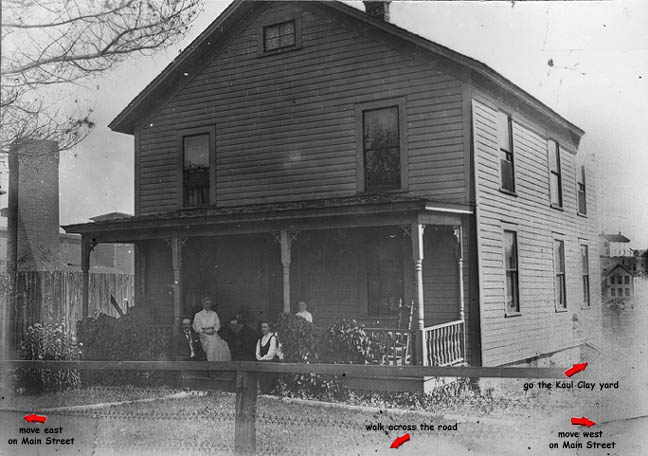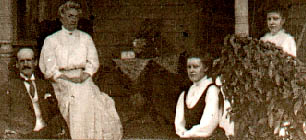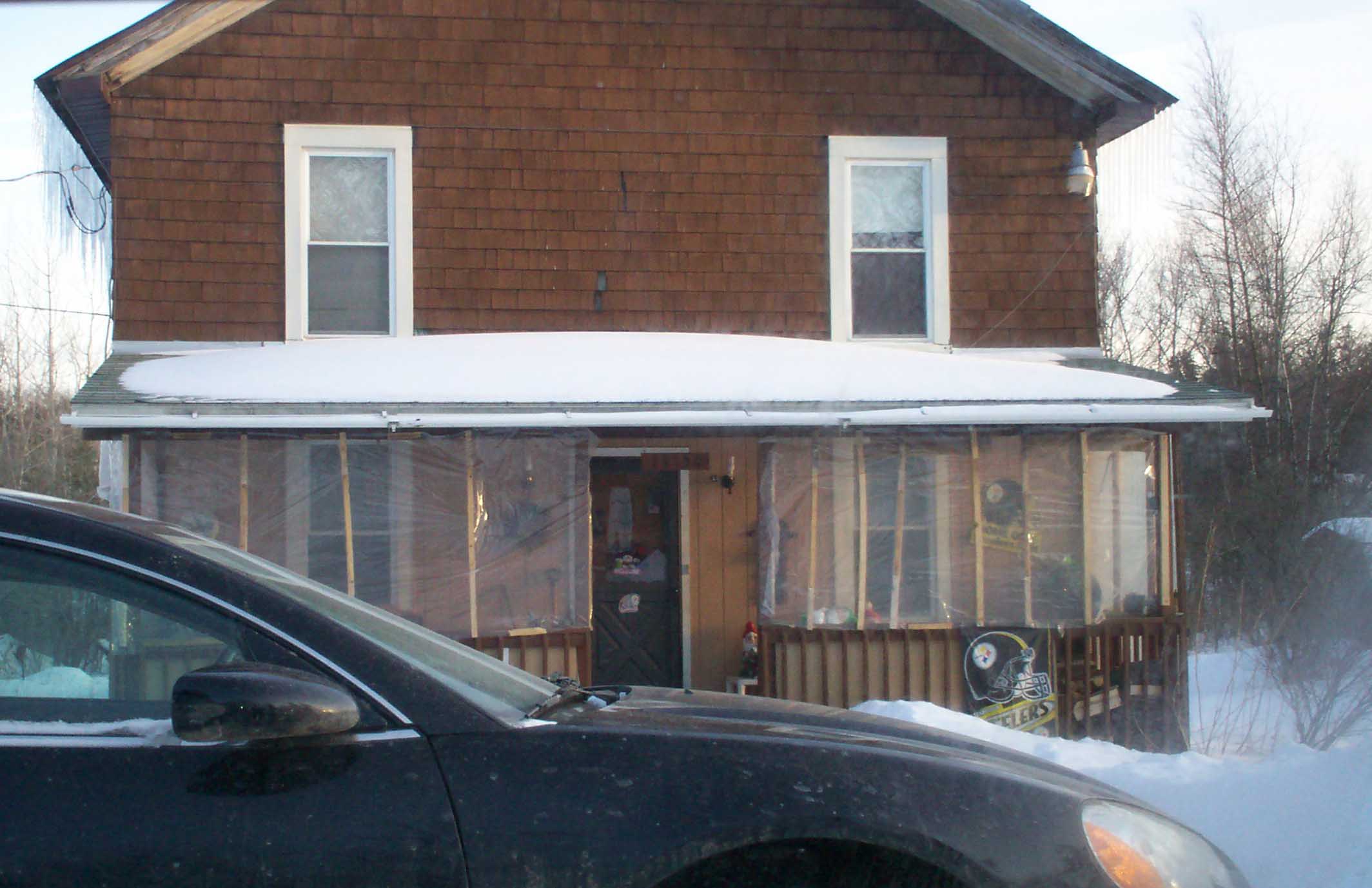The Kaul Clay Foreman's house
click to see the house in 2000 AD
click to see the house in 2007 AD

Photo Credit: David Johnson Collection
The Ringrose Family in 1906

The Ringrose Family in 1906
This house was built around 1900 by the Clermont Sewer Pipe Company for its foreman. Here, Foreman W. E. Ringrose and his family sit on the porch in August, 1907. In 1913 Peter Gallagher came to this house for assistance when mortally wounded in 1913. For many years it was occupied by local legend and Kaul Clay foreman Iroe Dibler. Since 1963 the Kenneth Johnson family has resided in this house.

The
crumbling kilns of Clermont's Kaul Clay Company look almost tranquil today.
Few would guess that they were the scene of a cold-blooded murder almost 90
years ago. The plant was built around the turn of the century and was known
as the Clermont Tile Company, the Clermont Sewer Pipe Company, and finally Kaul
Clay until the disastrous fire of 1961 destroyed it. In 1913 Clermont was still
a wild town. The village had seen a decline in population after the Buffalo
Coal Company had abandoned its mines, but the tile plant was a large employer.
The late Iroe Dibler, a foreman at the facility, would often tell of brawls
between loggers and miners, miners and clay workers, the Black Hand. Special
hatred was reserved for the Italians. Many of the miners and clay laborers,
as well as railroad personnel, were of Italian descent. How they were regarded
can be summed up by the fact they were segregated to a separate page titled
"Italians" in the Sergeant Township tax books of this period.
On August 8, 1913 John Gallagher
walked from Betula to Clermont. That road, still passable by foot or four-wheel
drive vehicle, had been constructed years earlier so persons in the in the Betula
and Norwich area could reach Clermont; it parallels Brewers Run, exiting near
the Hoover residence on the back road to Betula. Gallagher, an Irishman from
Emporium, was employed by the United Natural Gas Company, and had spent the
day building a pipeline. After a hard day's work, he was looking for excitement.
In 1913 Clermont had plenty of that.
He spent the evening frequenting the pool parlor and beer gardens. Gallagher
lost track of time,and soon found the local hotels were closed for the night.
Undaunted, he headed for the nearby tile plant, seeking refuge on that summer
night. As he walked along the dusty road, the glow of the kilns beckoned like
a lighthouse. There was a shift of only four laborers that night. John Chilla
was the night watchman, and P. H. Sullivan was the fireman. Over in the kiln
yard, Christi Peter and Tony Lozzo were firing a kiln, preparing another furnace
to make the tile pipe Clermont was famous for. Peter was a large man, with a
heavy moustache. On the other side of the kiln labored Lozzo, a small, clean-shaven
man who spoke no English. As Gallagher neared the kiln, he heard a shout. Someone
had yelled a derogatory name at him. Stopping, he heard a voice yell for him
to leave. Turning, he heard three shots ring out. The first plowed into his
hip from the rear. The impact threw him to the ground as the other two shots
hit the dirt nearby. The pain was unbearable as he crawled up the bank to the
Clermont-Milesburg Turnpike. The house of WE Ringrose, manager of the tile plant,
was nearby. The large framed house was a Mecca to the struggling Gallagher,
who crawled to the porch and shouted for help. Ringrose had been ill and didn't
venture outside. He called a few men, who arrived and carried the failing Gallagher
down to the Clermont House hotel. There he received temporary medical care until
a vehicle could be summoned to transport him to the Ridgway Hospital. Meanwhile,
Father Carpenter of the nearby Roman Catholic Church in Clermont came down to
the hotel and administered last rites. As the mortally stricken man was loaded
into a car, he said his last farewells, knowing his cause was a lost one. Death
was attributed to peritonitis, and a coroner's inquest was held. Coroner Sdherman
ordered the body sent to Smethport, so he and District Attorney Thomas Wilson
could begin their investigation. Meanwhile, Detective EW Jones was notified
of the heinous crime and hastened to Clermont. The evidence on hand prompted
Jones to arrest Lozzo and Peter. Doctors HL McCoy and Robert Hamilton, both
of Smethport, performed the autopsy and confirmed Gallagher had been shot in
the back, below the waist. A coroner's jury was formed; Samuel E Bell, LK Hogarth,
Oscar Engstrom, CL Irons, LH Foote and AA Hazen reviewed the remains in the
mortuary of Specht and Sasse. After hearing witnesses, they bound Christi over
for trial. ""he Macedonian"" as the local press called him, was remanded to
the County Jail. His attorney TF Mullin filed a writ of habeas corpus, which
was denied. In October Judge Bouton bound the case over for the December term.
Friends of Peter hired St Marys attorney DJ Driscoll. Meanwhile Christi became
friends with another accused murderer, Rosario Gigliotti, charged in the Bradford
slayings of Grace Bigler and Tony Kohnen. In December Gigliotti became the fifth
person executed in McKean County. However, the gallows had to be content with
the spirit of Gigliotti; when the verdict was pronounced, Peter was declared
insane and sent to Warren State Hospital.
Ringrose House 2007

photo credit: Levi Rounsville 2007